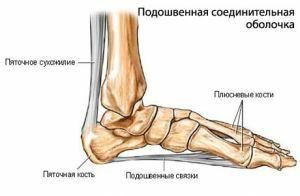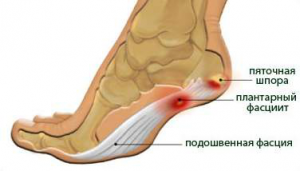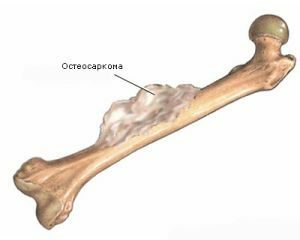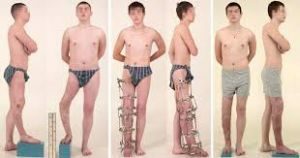 Plantar fasciitis is a disease that develops slowly and does not pay attention to it in the early stages.
Plantar fasciitis is a disease that develops slowly and does not pay attention to it in the early stages.
It is believed that pain or tension will pass after the feet rest. But, over time, the pain in the soles increases after rest.
The onset of the disease is observed much more often in women than in men, athletes, elderly people.
Contents of the article
- Anatomy of the foot
- Causes and risk factors
- How does the disease manifest itself?
- Diagnosis of pathology
- Therapy methods
- Traditional medicine
- Physiotherapeutic procedures
- Surgery - as an extreme method of therapy
- Traditional medicine
- How to prevent a disease?
Anatomy of the foot
The lower limbs are the only organ and support and movement of the human. The structure of the foot is designed to withstand the load when walking.
It consists of 26 bones, joints, muscles, tendons, fat pads, arteries and veins, nerve endings. The largest of the bones is the heel bone.
The heel of the heel is the main attachment point for the tendons and muscles on the foot. The fascia is attached to the calcaneus. This  connective tissue is the most powerful plate, which from the tip of the calcaneus extends all over the sole over the muscles and is attached by four rays to the bones of the toes.
connective tissue is the most powerful plate, which from the tip of the calcaneus extends all over the sole over the muscles and is attached by four rays to the bones of the toes.
The fascia refers to the ligamentous tissues and is in a stretched state, like a bow string, supports the longitudinal arch of the foot, regulating the load on the leg when walking.
Half the body weight of a man falls on the heel zone and creates a load on the plantar fascia. The greatest tension arises in the place of attachment to the heel of the heel.
Causes and risk factors
Due to the excessive load on this area, microfractures of the fascia can arise, which in most cases spontaneously heal if a person alternates with rest.
However, there are a number of cases in which the load on the feet multiplies.
The main reasons why plantar fasciitis develops and progresses:
- When wearing incorrectly picked up shoes, prolonged standing on the legs, exercising with weightlifting and other power sports, overweight develops flat feet.
- Age-related degenerative changes of lead to a reduction in the thickness of the subcutaneous fat tissue in the calcaneal region. This is the result of a worsening of blood microcirculation and a slowing down of the body's recovery processes.
- Formation of the valgus position of the first finger for arthritis ,( the bone goes inside and the finger curves outwards) - the first signal that the foot has an incorrect position, respectively, the heel becomes overloaded and there is a danger of plantar fasciitis.
- Disturbance of blood circulation and metabolic processes , which is caused by gout( leads to excessive deposition of salts), atherosclerosis, diabetes mellitus. Infectious diseases( gonorrhea, chlamydosis) and appears after a long time( minimum several months)
- Physical injuries of the heel bone , sprainsand joint diseases due to which the load is removed from the injured leg and transferred to a healthy one, which begins to experience an overload.
The fascia is constantly irritated by the bone and an inflammatory aseptic( non-microbial) process begins around the calcaneus on the sole.
This process underlies the calcaneus fasciitis. As the disease progresses, ossification of the inflamed area takes place and bone growth is formed. The reason for the pain is chronic inflammation of the heel zone of the foot.
How does the disease manifest itself?
The main symptom of the disease is pain. Pain in the area of the heel is more often on the plantar surface, less often on the posterior surface of the bone.
Pain appears initially due to the inflammatory process and over time due to a bony growth resembling a spike. Especially sharp, not giving on to a leg, happens since morning or after rest.
 The cause is repeated ruptures of damaged fascia sites, which began to grow together during sleep. In the afternoon the pain becomes less, but by the evening - it intensifies.
The cause is repeated ruptures of damaged fascia sites, which began to grow together during sleep. In the afternoon the pain becomes less, but by the evening - it intensifies.
If the disease passes into a chronic, shape with the formation of a calcaneal spur, a person tries to walk, leaning on the socks or the outer part of the foot, but not on the heel.
When inflammation of the fascia or the appearance of spurs has affected both legs without crutches or walking stick is indispensable.
Diagnosis of pathology
A preliminary diagnosis is made based on complaints and superficial palpation of the calcaneal region.
An X-ray shows the size of the spine and provides an opportunity to determine the method of treatment.
Treatment methods
The method of treatment depends on the results of the diagnosis and is directed, first of all, to the removal of pain.
Traditional medicine
In inflammatory processes without formation of bone outgrowth, preparations( non-steroidal anti-inflammatory or homeopathic) are prescribed to eliminate the inflammatory processes of the tissues around the calcaneus and increase the elasticity of the ligaments.
If the ligaments are elastic, even the presence of a spur will not cause acute pain. Non-steroidal anti-inflammatory drugs that reduce pain and are prescribed for a long time in small doses.
It is prescribed as a local treatment with ointments, compresses.
 Is it safe to treat joints with hydrogen peroxide? What is the essence of the unusual technique and what needs to be remembered in order not to harm your health.
Is it safe to treat joints with hydrogen peroxide? What is the essence of the unusual technique and what needs to be remembered in order not to harm your health. Surgery to remove part of the vertebrae laminectomy of the spine - when is this surgical intervention being prescribed and what are the risks?
Physiotherapeutic procedures
A good result with plantar fasciitis gives the use of physiotherapy:
- Magnetic resonance therapy is aimed at removing edema, inflammation, improving blood circulation.
- Shockwave therapy .The effect of acoustic waves of high frequency on soft foot tissues. In the process of acupressure, the blood supply in the calcaneal region is stimulated, and the inflammation is eliminated, the pain is relieved with the load, the tendons and ligaments are strengthened, the spur dissolves. The effect of this method is equal to surgical intervention.
- Laser( quantum) therapy .The laser beam acts directly on the subcutaneous tissue. Removes inflammation, swelling, activates the recovery processes.
- X-ray therapy .It is aimed at the elimination of pain due to the blocking by the X-ray of low dosage of radiation of nerve endings.
- Phonophoresis .Complex method, combining medicamental and physical effects. With the help of ultrasound, hydrocortisone ointment is introduced into the tissues of the calcaneal region. This penetration of the ointment has a strong anti-inflammatory effect. This leads to increased blood microcirculation, improved metabolism in cells, outflow of lymph.
Surgery - as an extreme method of therapy
Lack of results in conservative treatment leads to prompt intervention. Statistics showed that only about 70% of operations are effective. 
Relapse of the disease is not observed. The operation is performed under local anesthesia. An anesthetic is injected into the spine and blocks the sensitivity of the lower limbs.
The use of miniature surgical instruments enables modern surgeons, in addition to the traditional open surgery, to perform endoscopic surgery and minimally invasive dissection of the fascia, which are less traumatic and easier to tolerate by patients.
Endoscopic surgery is performed using miniature surgical instruments and a camera that helps to monitor the course of the operation.
Minimally invasive dissection of the fascia is performed using a microscopic scalpel attached to the end of a thin tube.
With its help, the fascia is cut off. After that, the scalpel is replaced with a milling cutter, which wears out a bone spine. The operation is carried out under the control of X-ray equipment.
Depending on the type of operation for rehabilitation, a different time is required. The minimal time is needed after a minimally invasive dissection of the fascia.
But this does not mean that you can become a sick leg in the near future. In addition, postoperative complications are possible in extreme cases:
- pain intensification;
- nerve injury during surgery;
- suppuration of the wound or its prolonged healing;
- the boring of neuroma( benign tumor) from enlarged nerve cells.
Traditional medicine
Treatment of plantar fasciitis at home is conservative, requires regularity and takes a long time. Applicable for the initial stages of the disease.
It includes compresses, rubbing, baths, lotions using paraffin, ozocerite, sea salt, medicinal plants and self-made ointments.
All procedures should be done in the evening before bedtime. Duration - until the disappearance of pain.
Apply these agents:
- Sea salt. For a bath, dissolve 1 kg of salt in 5 liters of hot water. Keep the feet until the solution is completely cool. Microelements of salt, penetrating through the expanded pores of the skin can increase the elasticity of the ligaments of the foot.
- Paraffin and ozocerite ( mountain wax) are used together in applications that warm the foot tissues well and feed them with microelements. The temperature of the heated mass should be about 40 degrees. It should be put on foot, wrapped in linen cloth, polyethylene and wrapped in a warm blanket. Warm your foot for 30 minutes. After the procedure, wear warm socks.
- Medical bile .Put a compress on steamed feet of linen fabric soaked in bile. Wrap polyethylene, fix and wear a sock. In the morning it is necessary to wipe the foot with alcohol.
- Bischofite .Natural brine brine rich in minerals( iron, magnesium, silicon, etc.) is extracted from deep rocks while drilling oil wells. Rubbed into the skin of the heated heel area of the foot. After rubbing the brine, attach to the rubbed part of the gauze cloth moistened with iodine cover with polyethylene, fix with elastic bandage and put on a woolen sock.
- Since ancient times, the disease was treated tincture of lilac flowers ( flowers pour vodka and insist in a dark place for 10 days) taking 30 drops inside and rubbing the heel area of the foot several times a day. And also applying fresh leaves of burdock, plantain, cabbage, horseradish, gruel of raw potatoes or black radish, changing them throughout the day at least three times.
How to prevent a disease?
Follow these guidelines:
- It is necessary to correctly choose with the help of orthopedist special orthopedic insoles and heels with an opening in the field of pathology. This will help fix the muscles and ligaments in the necessary position, reduce the load on the calcaneal tubercle and
 fascia and prevent its micro-ruptures. The insole design will help to avoid the development of flat feet due to the fixation of the arch of the foot. Strengthening the ligaments and reducing the load on the knee and hip joints of the feet will relieve fatigue and a feeling of heaviness in the legs.
fascia and prevent its micro-ruptures. The insole design will help to avoid the development of flat feet due to the fixation of the arch of the foot. Strengthening the ligaments and reducing the load on the knee and hip joints of the feet will relieve fatigue and a feeling of heaviness in the legs. - Insoles and heels make of several materials. Silicone well springs, able to support the foot when walking and with proper care for a long time does not wear out. Therefore, it is the best material for orthopedic insoles. Insole made of genuine leather is more rigid and wears out quickly. It is not advisable to use leatherette. Such insoles "steal" the leg and are short-lived. For everyday wearing with minor changes in the foot, gel is used.
- When overweight, adhering to a diet, reduce its .Drink within a day to 2 liters of water. This will help to remove salt from the body.
- It is compulsory for to do medical gymnastics .Refuse from sports creating excessive stress on joints and feet. They help to strengthen the muscles and ligaments of the foot by rolling the foot along the floor of cylindrical objects, shifting the small objects from place to place with your fingers, or pulling a towel clamped with your toes to yourself, without lifting the heels off the floor.
Plantar fasciitis does not appear suddenly, so a timely diagnosis will prevent the development of the inflammatory process and the subsequent formation of a bone build-up from the calcaneus.



